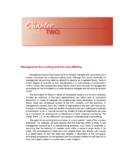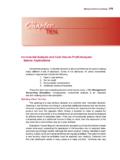Transcription of Inventory Decision-Making
1 management accounting | 195. Inventory Decision-Making To be successful, most businesses other than service businesses are required to carry Inventory . In these businesses, good management of Inventory is essential. The management of Inventory requires a number of decisions. Poor decision making regarding Inventory can cause: 1. Loss of sales because of stock outs. 2. Depending on circumstances, inadequate production for a period of time. 3. Increases in operating expenses due to unnecessary carrying costs or loss from discarding obsolete Inventory . 4. An increase in the per unit cost of finished goods. Of all the activities in a manufacturing business, Inventory creation is the most dynamic and certainly the most visible activity. In one sense, Inventory involves all production activity from the purchase of raw materials to the delivery of finished goods Inventory to the customer. The financial accounting for Inventory is concerned primarily with determining the correct count and the assignment of historical cost.
2 However, from a management accounting viewpoint, the central focus is on manufacturing the right amounts at the lowest cost consistent with a quality product. From a financial viewpoint, poor management of Inventory can adversely affect cash flow. Also, excessive Inventory can cause a decrease in ROI. An over stock of Inventory causes total assets to be larger and certain expenses to increase. Consequently, in addition to a reduced cash flow, the effect of poor Inventory management can be a lower rate of return. 196 | chapter ELEVEN Inventory Decision-Making Finished goods Inventory represents the company's product for available for sale at a given point in time. A certain amount of Inventory must be available at all times in order to have an effective marketing operation. The poor management of Inventory , including finished goods, is often reflected in the use of terms such as such as stock outs, back orders, decrease in Inventory turnover, lost sales, and inadequate safety stock.
3 The existence of Inventory results in expenses other than the cost of Inventory itself which typically are categorized as: 1. Carrying costs 2. Purchasing costs. Inventory is a term that may mean finished goods, materials, and work in process. In a manufacturing business, there is a logical connection between these three types of Inventory : Materials Labor Work in Process Finished goods Cost of goods sold Overhead To have finished goods Inventory , production must take place at a rate greater than sales. Inventory decisions have a direct impact on production. For example, a decision to increase safety stock means that the production rate must increase until the desired level of safety stock is achieved. From an accounting standpoint, there are two main areas of concern. First, from a financial accounting viewpoint, the main accounting problems concern: 1. The flow of costs (FIFO, LIFO, average cost). 2. Use of a type of Inventory costing method (periodic or perpetual).
4 3. Taking of physical inventories. 4. Techniques for estimating Inventory From a financial accounting viewpoint, the cost assigned to Inventory directly affects net income. If ending Inventory is overstated, then net income is overstated and conversely, if ending Inventory is understated then net income is understated. Also, the use of direct costing rather than absorption costing can affect net income as discussed in chapter 6. From a management accounting viewpoint, there are variety of Inventory decisions that affect net income. Decisions regarding Inventory can be placed in two general categories: (1) those decisions that affect the quantity of Inventory and (2) those decisions that affect the per unit cost of Inventory . Decisions that affect the quantity of Inventory 1. Order size 2. Number of orders 3. Safety stock 4. Lead time 5. Planned production management accounting | 197. Decisions that affect the cost per unit of Inventory 1.
5 Suppliers of raw material (list price and discounts). 2. Order size (quantity discounts). 3. Freight In addition, decisions pertaining to labor and overhead also indirectly affect the per unit cost of Inventory . In a manufacturing business, the costs of labor and overhead do not become operating expenses until the manufacturing costs appear as part of cost of goods sold. Labor and overhead costs are deferred in Inventory until the Inventory has been sold. In this chapter , the main focus of discussion will be the following Inventory decisions: 1. Production budget 2. Order size for raw materials 3. Number of times to order for raw materials 4. Reorder point 5. Safety stock Production Budget Decision The production budget was discussed in some detail in chapter 8. The production budget decision is of utmost importance. If the production budget is inadequate, then stock outs will occur. If the production budget is too large, then unnecessary carrying costs will be incurred.
6 The production budget format as presented previously was: Production Budget For the Quarter Ending March 31, 20xx Sales forecast $100,000. Back orders 5,000. Desired ending Finished Goods Inventory 20,000. _____. 25,000. Finished goods (BI) 10,000. _____. $115,000. The key to a good production management is an accurate sales forecast. Without a reliable sales forecast, the production process is likely to be chaotic and have a significant negative impact on sales. A good production budget is one that meets the current sales demand plus provides for an adequate planned safety stock. Also, in the preparation of the purchases budget, decisions for the desired levels of safety stock in materials must be made. The production budget determines the need for plant capacity. If the current production budget exceeds existing plant capacity, then ways to increase plant capacity must be considered. Increasing plant capacity may involve scheduling overtime or a second shift or even purchasing and installing more production equipment and hiring additional labor.
7 198 | chapter ELEVEN Inventory Decision-Making Purchase of Materials Decision The main management accounting tool that may be used to make Inventory purchase decisions is the EOQ model. This tool recognizes that there are two major decisions regarding the materials Inventory : (1) orders size and (2) number of orders. There are consequently two major questions: 1. How many units should be purchased each time a purchase is made (order size)? 2. How many purchases should be made (number of orders)? To understand an EOQ model, it is essential that the concept of average Inventory be understood. Inventory is never static and is constantly rising and falling over time, even in the very short term. Inventory , for example, rises when raw materials are purchased and falls when raw material is used. Because Inventory in a business is constantly changing, it is necessary to think in terms of average Inventory levels. The high points and low points of Inventory are easy to explain and illustrate, if a purchasing policy is consistently applied and the rate of usage of raw material is uniform.
8 Inventory is at its highest and lowest levels when a new shipment of material arrives. Theoretically, in absence of a need for safety stock, a new shipment should arrive at the moment Inventory reaches zero. Immediately, upon arrival of a new shipment, Inventory is then at its highest level again. To illustrate, assume that each purchase order placed is for 18,000 units at $ per unit and that usage of raw materials is uniform at 300 units of material per day. If production and usage of material takes place every day, then a shipment of material should last 60 days. These conditions may be illustrated as follows: Figure 11-1 Graphical Illustration of Average Inventory Units 18,000. Average 9,000. Inventory 0. 60 120 180 240 300 360 Work Days In terms of dollars, the amount invested in Inventory would fluctuate between $90,000 and zero. In this example, the average Inventory would be 9,000 computed as follows: Order size Average Inventory = (1).
9 2. management accounting | 199. At its highest level Inventory would be 18,000 units and at its lowest level Inventory would be 0. Based on the above equation average Inventory is: AI = (18,000 + 0)/ 2 = 9,000. The major factor here that affects the level of Inventory is order size ( the number of units purchased in each order). If demand for materials for a full year is 108,000. units, then the extremes for purchasing could be one large order of 108,000 or 108,000 orders of one unit per order. Given these extremes, then average Inventory could be as low as .5 unit (1 /2) or as large as 54,000 (108,000 / 2). The best order size, as will be explained and illustrated now, is determined by the cost of ordering (purchasing) and the cost of carrying Inventory . Purchasing Cost The purchase of materials or parts necessary to make a finished product involves a process that needs to be understood. The process begins with a purchase requisition and finally ends with payment of the materials purchases.
10 This process may be illustrated as follows: Purchase Purchase Delivery Receiving and Preparation Payment of Requisition Order of Inspection of of Voucher Purchase . Order order and accounting The cost of placing an order, therefore, consists of the following: 1. Cost of preparing purchase requisition 2. Cost of preparing purchase order 3. Delivery of order (postage, telephone time, filing). 4. Receiving of purchased materials (inspection, storing, receiving report. 5. accounting costs (preparing vouchers and recording time). It is important to remember that the cost of the Inventory itself is not a purchasing cost. The purchase of Inventory is typically recorded to the materials purchases account and is treated as a separate and distinct cost. The number of times an order is placed is to some extent discretionary. To illustrate, assume that the K. L. Widget Company has determined that for the current quarter 100,000 units of raw material Y need to be purchased.)





